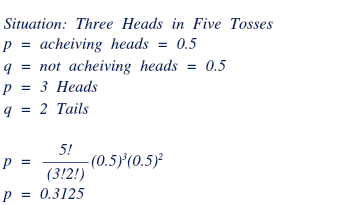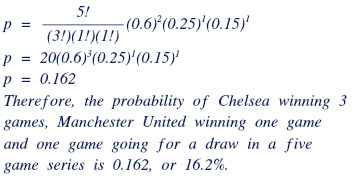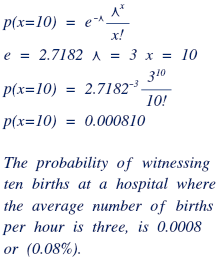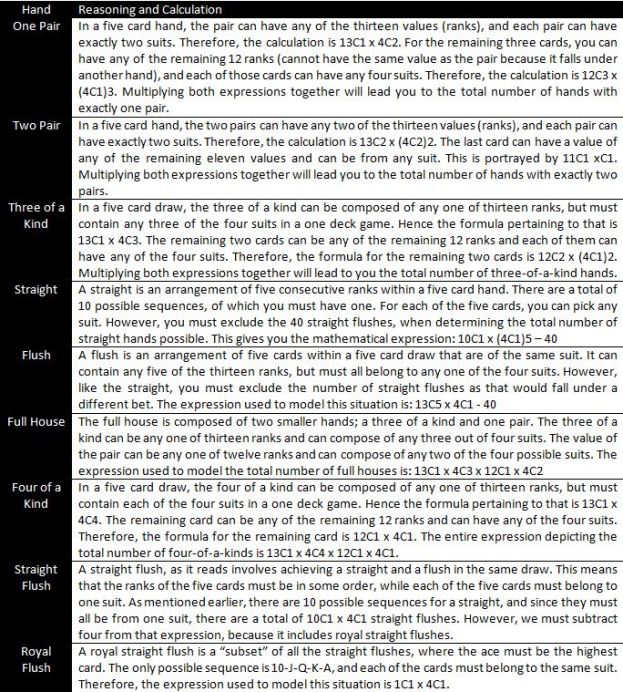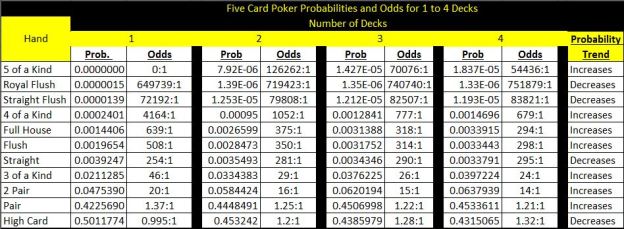As you and your friend travel one thousand miles to watch a series of Barclays Premier League football, the two of you deliberate the probability distributions for the possible results over the five game series. Conversely, it hits you right in the face, at MDM4U in school, you learnt calculating probability distributions for binomial circumstances, but football always encompasses a draw. You could manipulate the probabilities and count a “draw” as a loss, but would that really be a representative probability distribution? Undoubtedly not, unless you or your friend were rooting for one team so badly, that any result against them counted as a loss.
In class, Bernoulli trials in connotation with binomial distributions were conferred. As a reminder, let us take the time to revisit Bernoulli trials and binomial distributions. Bernoulli trials are recurrent, independent, indistinguishable trials measured in terms of success or failure. Several examples of independent trials include tossing a coin one hundred times, rolling a pair of dice, or pass and fail situations. Binomial distributions are probability distributions where a definite outcome is anticipated, and where there are two possible results; success or failure. The probability of success is denoted as p, while the probability of failure is denoted as q. The sum of these two probabilities, must, in all situations be equal to one. Let us take an example; what is the probability of tossing exactly three heads out of five tosses? The first step is to determine the success and failure, along with the probabilities and desired number of successes and failures, respectively. Therefore, the probability of achieving exactly three heads in five tosses is 0.3125 (10/32).
Going back to the football example, the situation of a draw is not covered by a binomial distribution, so, what do we do? Instead of using the binomial distribution, where there are two outcomes (success and failure), we proceed to using the formula for multinomial distribution, which allows infinite (n) outcomes, as long as the probabilities for (n-1) outcomes are defined, and the number of desired outcomes are also defined. Suppose you were attending the game series between Chelsea and Manchester United, the probability of Chelsea winning is 60%, while the probability of Manchester United winning is 25%. The probability of a draw is the remaining 15%. If the series was five games long, what is the probability of three Chelsea wins, one Manchester United win and one draw? And what is the number of expected Chelsea wins, Manchester United wins and draws in the five game series?
The first step towards solving this issue is to gather the formula, and identify all the values associated with it. The formula for multinomial distributions is similar to that of the binomial distributions, with the only difference being an added outcome, denoted as “r” or “n3”. In the football instance, n equals to five, because the game series is five matches long. The desired outcomes are three Chelsea wins (probability of Chelsea winning is 60%), one Manchester United win (probability of Manchester United winning is 25%),and one draw (probability of one match going for a draw is 15%). Subsequently, the values are to be entered into the formula and calculated based “on the order of operations”. After doing the above mentioned, the probability of Chelsea winning three games, Manchester United winning one game and one game stalemated, is attained, and is found to be 0.162 (or 16.2%).
However, only parts of your queries are answered. As a football fanatic, you still do not know how many games your team is expected to win, or how many draws are expected to be part of the series? Recall that the formula for obtaining the expected number of successes in a binomial distribution was simply n x p (where n was the number of times the experiment/event occurred, and p was the probability of success). Similarly, the expected value for the number of desired outcomes can be obtained by multiplying the number of events/experiments by the probability of the desired outcome.
In the situation of the football series, the probabilities are 60%, 25% and 15% respectively, while the number of games occurring within the series is five. As a result, the expected values for the series are three Chelsea wins, one Manchester United win, and one draw. In summary, situations where the number of outcomes are greater than two require more than a binomial distribution, hence the multinomial distribution is an effective manner in which the probabilities for situations that include more than two possible outcomes. Similarly, the expected value can also be calculated for these situations. The multinomial distribution can easily be used in situations like chess, stock prices, sporting events, and any other situation involving more than two possible outcomes. However, what about situations in which rates are involved?
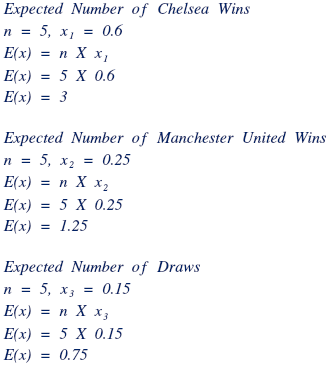 Over a century ago, French mathematician Simeon-Denis Poisson developed, what is known today as the Poisson distribution. There are several uses for the Poisson distribution. For instance, this style of distribution can be used to approximate the binomial distribution if the value of p is miniscule, but the value of n is extremely large. However, the more common use of the Poisson distribution is when an average rate of occurrence is given. It is especially used when the mean number of successes (predetermined outcome) is given, and the probabilities of various numbers of successes are required. By definition, the Poisson distribution is a discrete probability distribution for the counts of events that occur randomly in a given interval of time (or space). The Poisson distribution only works if the events are independent. The formula for the Poisson distribution is shown below:
Over a century ago, French mathematician Simeon-Denis Poisson developed, what is known today as the Poisson distribution. There are several uses for the Poisson distribution. For instance, this style of distribution can be used to approximate the binomial distribution if the value of p is miniscule, but the value of n is extremely large. However, the more common use of the Poisson distribution is when an average rate of occurrence is given. It is especially used when the mean number of successes (predetermined outcome) is given, and the probabilities of various numbers of successes are required. By definition, the Poisson distribution is a discrete probability distribution for the counts of events that occur randomly in a given interval of time (or space). The Poisson distribution only works if the events are independent. The formula for the Poisson distribution is shown below:
With regards to the Poisson distribution, the mean is equal to λ, while the standard deviation is equal to the square root of the mean. As an example, you were tasked with calculating the probability of observing 10 births in a given hour at the hospital, with the average rate of births per hour at the hospital being only 3. The first step is to provide a let statement, that x equals the number of births in a given hour. Consequently, a Poisson distribution statement must be written. The general formula for that is X – Po(λ). Therefore, the general statement for this instance is X – Po(3). The mean of the births per hour at the hospital is 3, while x is 10. After inputting all the information into the formula, you would realize that the probability of the desired outcome is 0.08%.
In summation, where the binomial distribution is unable to provide probabilities for situations, the multinomial distribution can be used when the number of outcomes exceeds two, and the Poisson distribution can be used when rates are provided, or the probability is too small and the sample is too big to use the binomial distribution.
References:
http://www.youtube.com/watch?v=tx9wspMQvoY
http://www.statlect.com/mddmln1.htm
http://warnercnr.colostate.edu/~gwhite/fw663/MultinomialDistribution.PDF
http://www.math.uah.edu/stat/bernoulli/Multinomial.html
http://onlinestatbook.com/2/probability/multinomial.html
http://ncalculators.com/math-worksheets/poisson-distribution-example.htm
http://ncalculators.com/statistics/poisson-distribution-calculator.htm
http://easycalculation.com/statistics/learn-poisson-distribution.php
http://www.stats.ox.ac.uk/~marchini/teaching/L5/L5.notes.pdf
http://onlinestatbook.com/2/probability/poisson.html

